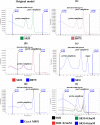Rapid Detection of Antimicrobial Resistance in Mycoplasma genitalium by High-Resolution Melting Analysis with Unlabeled Probes
- PMID: 35880894
- PMCID: PMC9430336
- DOI: 10.1128/spectrum.01014-22
Rapid Detection of Antimicrobial Resistance in Mycoplasma genitalium by High-Resolution Melting Analysis with Unlabeled Probes
Abstract
With looming resistance to fluoroquinolones in Mycoplasma genitalium, public health control strategies require effective antimicrobial resistance (AMR) diagnostic methods for clinical and phenotypic AMR surveillance. We developed a novel AMR detection method, MGparC-AsyHRM, based on the combination of asymmetric high-resolution melting (HRM) technology and unlabeled probes, which simultaneously performs M. genitalium identification and genotypes eight mutations in the parC gene that are responsible for most cases of fluoroquinolone resistance. These enhancements expand the traditional HRM from the conventional detection of single-position mutations to a method capable of detecting short fragments with closely located AMR positions with a high diversity of mutations. Based on the results of clinical sample testing, this method produces an accordance of 98.7% with the Sanger sequencing method. Furthermore, the specificity for detecting S83I, S83N, S83R, and D87Y variants, the most frequently detected mutations in fluoroquinolone resistance, was 100%. This method maintained a stable and accurate performance for genomic copies at rates of ≥20 copies per reaction, demonstrating high sensitivity. Additionally, no specific cross-reactions were observed when testing eight common sexually transmitted infection (STI)-related agents. Notably, this work highlights the significant potential of our method in the field of AMR testing, with the results suggesting that our method can be applied in a range of scenarios and to additional pathogens. In summary, our method enables high throughput, provides excellent specificity and sensitivity, and is cost-effective, suggesting that this method can be used to rapidly monitor the molecular AMR status and complement current AMR surveillance. IMPORTANCE Mycoplasma genitalium was recently added to the antimicrobial-resistant (AMR) threats "watch list" of the U.S. Centers for Disease Control and Prevention because this pathogen has become extremely difficult to treat as a result of increased resistance. M. genitalium is also difficult to culture, and therefore, molecule detection is the only method available for AMR testing. In this work, we developed a novel AMR detection method, MGparC-AsyHRM, based on the combination of asymmetrical HRM technology and unlabeled probes, and it simultaneously performs M. genitalium identification and genotypes eight mutations in the parC gene that are responsible for most cases of fluoroquinolone resistance. The MGparC-AsyHRM method is a high-throughput, low-cost, simple, and culture-free procedure that can enhance public health and management of M. genitalium infections and AMR control, providing a strong complement to phenotypic AMR surveillance to address the spread of fluoroquinolone resistance.
Keywords: Mycoplasma genitalium; antimicrobial resistance; high-resolution melting technology; unlabeled probe.
Conflict of interest statement
The authors declare no conflict of interest.
Figures



Similar articles
-
Macrolide and fluoroquinolone associated mutations in Mycoplasma genitalium in a retrospective study of male and female patients seeking care at a STI Clinic in Guangzhou, China, 2016-2018.BMC Infect Dis. 2020 Dec 11;20(1):950. doi: 10.1186/s12879-020-05659-3. BMC Infect Dis. 2020. PMID: 33308173 Free PMC article.
-
Multicenter Clinical Evaluation of a Novel Multiplex Real-Time PCR (qPCR) Assay for Detection of Fluoroquinolone Resistance in Mycoplasma genitalium.J Clin Microbiol. 2019 Oct 23;57(11):e00886-19. doi: 10.1128/JCM.00886-19. Print 2019 Nov. J Clin Microbiol. 2019. PMID: 31434719 Free PMC article.
-
Prevalence of mutations associated with resistance to macrolides and fluoroquinolones in Mycoplasma genitalium: a systematic review and meta-analysis.Lancet Infect Dis. 2020 Nov;20(11):1302-1314. doi: 10.1016/S1473-3099(20)30154-7. Epub 2020 Jul 2. Lancet Infect Dis. 2020. PMID: 32622378
-
Detection of markers predictive of macrolide and fluoroquinolone resistance in Mycoplasma genitalium from patients attending sexual health services.Sex Transm Infect. 2022 May;98(3):215-218. doi: 10.1136/sextrans-2020-054897. Epub 2021 Jun 4. Sex Transm Infect. 2022. PMID: 34088790
-
Mycoplasma genitalium and antimicrobial resistance in Europe: a comprehensive review.Int J STD AIDS. 2020 Mar;31(3):190-197. doi: 10.1177/0956462419890737. Epub 2020 Jan 30. Int J STD AIDS. 2020. PMID: 32000587 Review. No abstract available.
Cited by
-
Fast Track Diagnostic Tools for Clinical Management of Sepsis: Paradigm Shift from Conventional to Advanced Methods.Diagnostics (Basel). 2023 Jan 11;13(2):277. doi: 10.3390/diagnostics13020277. Diagnostics (Basel). 2023. PMID: 36673087 Free PMC article. Review.
-
Integrating Genomic Data with the Development of CRISPR-Based Point-of-Care-Testing for Bacterial Infections.Curr Clin Microbiol Rep. 2024;11(4):241-258. doi: 10.1007/s40588-024-00236-7. Epub 2024 Oct 15. Curr Clin Microbiol Rep. 2024. PMID: 39525369 Free PMC article. Review.
-
Detection of macrolide and fluoroquinolone resistance-associated 23S rRNA and parC mutations in Mycoplasma genitalium by nested real-time PCR.Front Cell Infect Microbiol. 2023 Oct 20;13:1271392. doi: 10.3389/fcimb.2023.1271392. eCollection 2023. Front Cell Infect Microbiol. 2023. PMID: 37928183 Free PMC article.
-
Rapid Detection of Predominant SARS-CoV-2 Variants Using Multiplex High-Resolution Melting Analysis.Microbiol Spectr. 2023 Jun 15;11(3):e0005523. doi: 10.1128/spectrum.00055-23. Epub 2023 May 16. Microbiol Spectr. 2023. PMID: 37191515 Free PMC article.
-
Advances in genotypic antimicrobialresistance testing: a comprehensive review.Sci China Life Sci. 2025 Jan;68(1):130-143. doi: 10.1007/s11427-023-2570-4. Epub 2024 Sep 18. Sci China Life Sci. 2025. PMID: 39300049 Review.
References
Publication types
MeSH terms
Substances
LinkOut - more resources
Full Text Sources
Other Literature Sources

